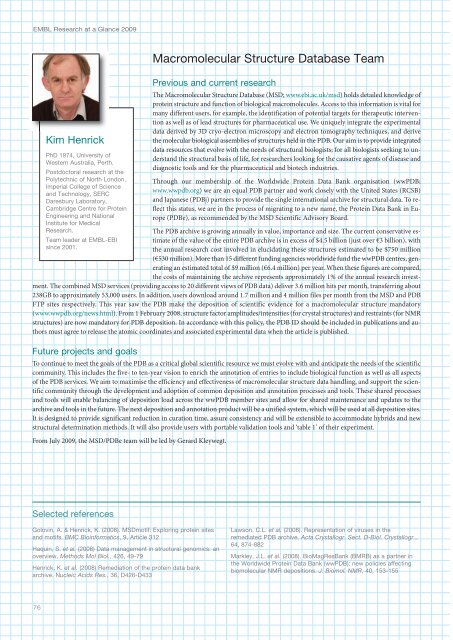You also want an ePaper? Increase the reach of your titles
YUMPU automatically turns print PDFs into web optimized ePapers that Google loves.
<strong>EMBL</strong> Research at a Glance 2009<br />
Kim Henrick<br />
PhD 197, University of<br />
Western Australia, Perth.<br />
Postdoctoral research at the<br />
Polytechnic of North London,<br />
Imperial College of Science<br />
and Technology, SERC<br />
Daresbury Laboratory,<br />
Cambridge Centre for Protein<br />
Engineering and National<br />
Institute for Medical<br />
Research.<br />
Team leader at <strong>EMBL</strong>-EBI<br />
since 2001.<br />
Macromolecular Structure Database Team<br />
Previous and current research<br />
The Macromolecular Structure Database (MSD; www.ebi.ac.uk/msd) holds detailed knowledge of<br />
protein structure and function of biological macromolecules. Access to this information is vital for<br />
many different users, for example, the identification of potential targets for therapeutic intervention<br />
as well as of lead structures for pharmaceutical use. We uniquely integrate the experimental<br />
data derived by 3D cryo-electron microscopy and electron tomography techniques, and derive<br />
the molecular biological assemblies of structures held in the PDB. Our aim is to provide integrated<br />
data resources that evolve with the needs of structural biologists; for all biologists seeking to understand<br />
the structural basis of life, for researchers looking for the causative agents of disease and<br />
diagnostic tools and for the pharmaceutical and biotech industries.<br />
Through our membership of the Worldwide Protein Data Bank organisation (wwPDB;<br />
www.wwpdb.org) we are an equal PDB partner and work closely with the United States (RCSB)<br />
and Japanese (PDBj) partners to provide the single international archive for structural data. To reflect<br />
this status, we are in the process of migrating to a new name, the Protein Data Bank in Europe<br />
(PDBe), as recommended by the MSD Scientific Advisory Board.<br />
The PDB archive is growing annually in value, importance and size. The current conservative estimate<br />
of the value of the entire PDB archive is in excess of $4.5 billion (just over €3 billion), with<br />
the annual research cost involved in elucidating these structures estimated to be $750 million<br />
(€530 million). More than 15 different funding agencies worldwide fund the wwPDB centres, generating<br />
an estimated total of $9 million (€6.4 million) per year. When these figures are compared,<br />
the costs of maintaining the archive represents approximately 1% of the annual research investment.<br />
The combined MSD services (providing access to 20 different views of PDB data) deliver 3.6 million hits per month, transferring about<br />
238GB to approximately 53,000 users. In addition, users download around 1.7 million and 4 million files per month from the MSD and PDB<br />
FTP sites respectively. This year saw the PDB make the deposition of scientific evidence for a macromolecular structure mandatory<br />
(www.wwpdb.org/news.html). From 1 February 2008, structure factor amplitudes/intensities (for crystal structures) and restraints (for NMR<br />
structures) are now mandatory for PDB deposition. In accordance with this policy, the PDB ID should be included in publications and authors<br />
must agree to release the atomic coordinates and associated experimental data when the article is published.<br />
Future projects and goals<br />
To continue to meet the goals of the PDB as a critical global scientific resource we must evolve with and anticipate the needs of the scientific<br />
community. This includes the five- to ten-year vision to enrich the annotation of entries to include biological function as well as all aspects<br />
of the PDB services. We aim to maximise the efficiency and effectiveness of macromolecular structure data handling, and support the scientific<br />
community through the development and adoption of common deposition and annotation processes and tools. These shared processes<br />
and tools will enable balancing of deposition load across the wwPDB member sites and allow for shared maintenance and updates to the<br />
archive and tools in the future. The next deposition and annotation product will be a unified system, which will be used at all deposition sites.<br />
It is designed to provide significant reduction in curation time, assure consistency and will be extensible to accommodate hybrids and new<br />
structural determination methods. It will also provide users with portable validation tools and ‘table 1’ of their experiment.<br />
From July 2009, the MSD/PDBe team will be led by Gerard Kleywegt.<br />
Selected references<br />
Golovin, A. & Henrick, K. (2008). MSDmotif: Exploring protein sites<br />
and motifs. BMC Bioinformatics, 9, Article 312<br />
Haquin, S. et al. (2008) Data management in structural genomics: an<br />
overview. Methods Mol Biol., 26, 9-79<br />
Henrick, K. et al. (2008) Remediation of the protein data bank<br />
archive. Nucleic Acids Res., 36, D26-D33<br />
Lawson, C.L. et al. (2008). Representation of viruses in the<br />
remediated PDB archive. Acta Crystallogr. Sect. D-Biol. Crystallogr.,<br />
6, 87-882<br />
Markley, J.L. et al. (2008). BioMagResBank (BMRB) as a partner in<br />
the Worldwide Protein Data Bank (wwPDB): new policies affecting<br />
biomolecular NMR depositions. J. Biomol. NMR, 0, 153-155<br />
76













